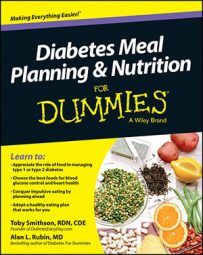A1C, sometimes called hemoglobin A1C or HbA1C, is the A of the diabetes ABCs. Your doctor orders a lab test of your hemoglobin A1C periodically; diabetes professionals pay careful attention to this number. Here are two important facts you should know now:
A1C measures your average blood glucose levels over the 60 to 90 day period before the test. Even though yesterday’s blood glucose level influences the A1C value more than your level 6 weeks ago — a weighted average — A1C gives the clearest picture of blood glucose control hour to hour, day to day, and week to week.
This test is especially important for people with type 2 diabetes who do not frequently test their blood glucose levels at home.
A1C values are closely correlated with your risk for many diabetes-related complications, like heart disease and kidney failure. In that regard, the target values set for blood glucose control by the American Diabetes Association (ADA) or the American College of Clinical Endocrinologists (ACCE) are numbers with real meaning. The ADA target is an A1C less than 7 percent, and the ACCE target is less than 6.5 percent.
The table shows the correlation between the A1C level and weighted average blood glucose in milligrams per deciliter (mg/dl) and in millimoles per liter (mmol/l). Remember that a normal fasting blood glucose level is 99 mg/dl (5.5 mmol/l) or lower, but levels rise after eating for everyone.
The A1C target values represent the level of blood glucose control those organizations view as being both achievable, and effective at minimizing the risk for complications.
Highly respected studies, including the Diabetes Control and Complications Trial (DCCT) in the U.S. and the United Kingdom Prospective Diabetes Study (UKPDS), demonstrated striking reductions in the risk for complications with improved A1C values. The DCCT showed each 1 percent reduction in A1C represented a 37 percent decrease in the risk for complications of the eye, kidneys, and nerves.
A recent study in Sweden tracked 12,000 people with diabetes who all began with A1C values averaging 7.8 percent. Over time, researchers grouped subjects into those with improving A1C (who eventually averaged A1C 7 percent), and those with A1C that remained the same or went higher (averaged A1C 8.4 percent).
The group that gained control of blood glucose and improved their A1C showed a 40 percent decrease in the risk for cardiovascular complications and death.
| A1C Value Corresponds To | Blood Glucose mg/dl | Blood Glucose mmol/l |
|---|---|---|
| 5.0% | 101 mg/dl | 5.6 mmol/l |
| 6.0% | 136 mg/dl | 7.6 mmol/l |
| 6.5%* | 154 mg/dl | 8.6 mmol/l |
| 7.0%** | 172 mg/dl | 9.6 mmol/l |
| 8.0% | 207 mg/dl | 11.6 mmol/l |
| 10.0% | 279 mg/dl | 15.6 mmol/l |
| 12.0% | 350 mg/dl | 19.5 mmol/l |
* recommended target of the American College of Clinical Endocrinologists
** recommended target of the American Diabetes Association
Controlling blood glucose levels consistently, and achieving the A1C targets, is incredibly important to your long-term health. The choices you make every day about the foods you eat will have the greatest impact on your A1C and on the quality of your future.

